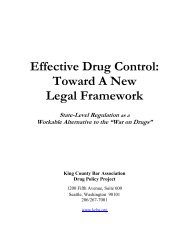RACE AND THE ENFORCEMENT OF DRUG DELIVERY LAWS IN ...
RACE AND THE ENFORCEMENT OF DRUG DELIVERY LAWS IN ...
RACE AND THE ENFORCEMENT OF DRUG DELIVERY LAWS IN ...
You also want an ePaper? Increase the reach of your titles
YUMPU automatically turns print PDFs into web optimized ePapers that Google loves.
In short, even if we limit our attention to more serious and low-income drug<br />
abusers, and ignore recreational (and mostly white) users such as the 26,000<br />
Seattle residents who report recently using ecstasy, it appears that crack cocaine<br />
is the drug of choice among less than one-fourth of Seattle’s poor drug abusers. A<br />
larger proportion—about one-third—of those admitted to public treatment<br />
programs primarily abused heroin.<br />
Still, if it were true that crack cocaine users made far more frequent purchases<br />
than users of other serious drugs, this might mean that a majority of Seattle drug<br />
transactions involve crack cocaine. However, the evidence does not support this<br />
conjecture. According to the best available data, crack cocaine users do make<br />
more frequent monthly purchases than methamphetamine and powder cocaine<br />
users, but fewer average monthly purchases than heroin users. Specifically,<br />
ADAM survey data indicate that powder cocaine users typically made 4<br />
purchases of that substance per month, methamphetamine users made 3<br />
purchases per month, crack cocaine users made 15 monthly purchases and<br />
heroin users made 20.5 purchases per month. 123<br />
In sum, the best available data indicate that recreational users of powder cocaine<br />
and ecstasy significantly outnumber more serious abusers of heroin, crack<br />
cocaine and other serious drugs. Even if we focus solely on low-income drug<br />
abusers, treatment admission data indicate that there are more heroin abusers<br />
than crack cocaine abusers in Seattle. The evidence also indicates that those who<br />
use heroin make more frequent purchases than those who use crack cocaine.<br />
When combined with the fact that there are also many recreational users and<br />
abusers of ecstasy, powder cocaine, methamphetamine and prescription drugs, it<br />
becomes clear that a significant majority of the serious drug transactions that<br />
take place in Seattle involve a drug other than crack cocaine. Thus, it does not<br />
appear that the frequency with which crack cocaine is exchanged explains the<br />
preponderance of crack cocaine delivery arrests.<br />
Moreover, the analysis of the downtown market casts doubt on the frequency<br />
hypothesis. Recall that the needle exchange survey results indicate that 12<br />
123 Data regarding the number of past-month acquisitions and location of last drug transaction<br />
are based on the results of ADAM surveys with King County respondents arrested by the SPD<br />
between January 2000 and September 2001. (Ad-hoc analysis of Seattle ADAM data by Joe<br />
Kabel, Ph.D., Seattle ADAM Site Director, Looking Glass Analytics, and Michael Gilson, Ph.D.,<br />
Research Analyst, Looking Glass Analytics). The median number of past month acquisitions is<br />
presented in the text above. Unfortunately, Seattle-King County is no longer included in the<br />
ADAM survey so these figures cannot be updated.<br />
82

















